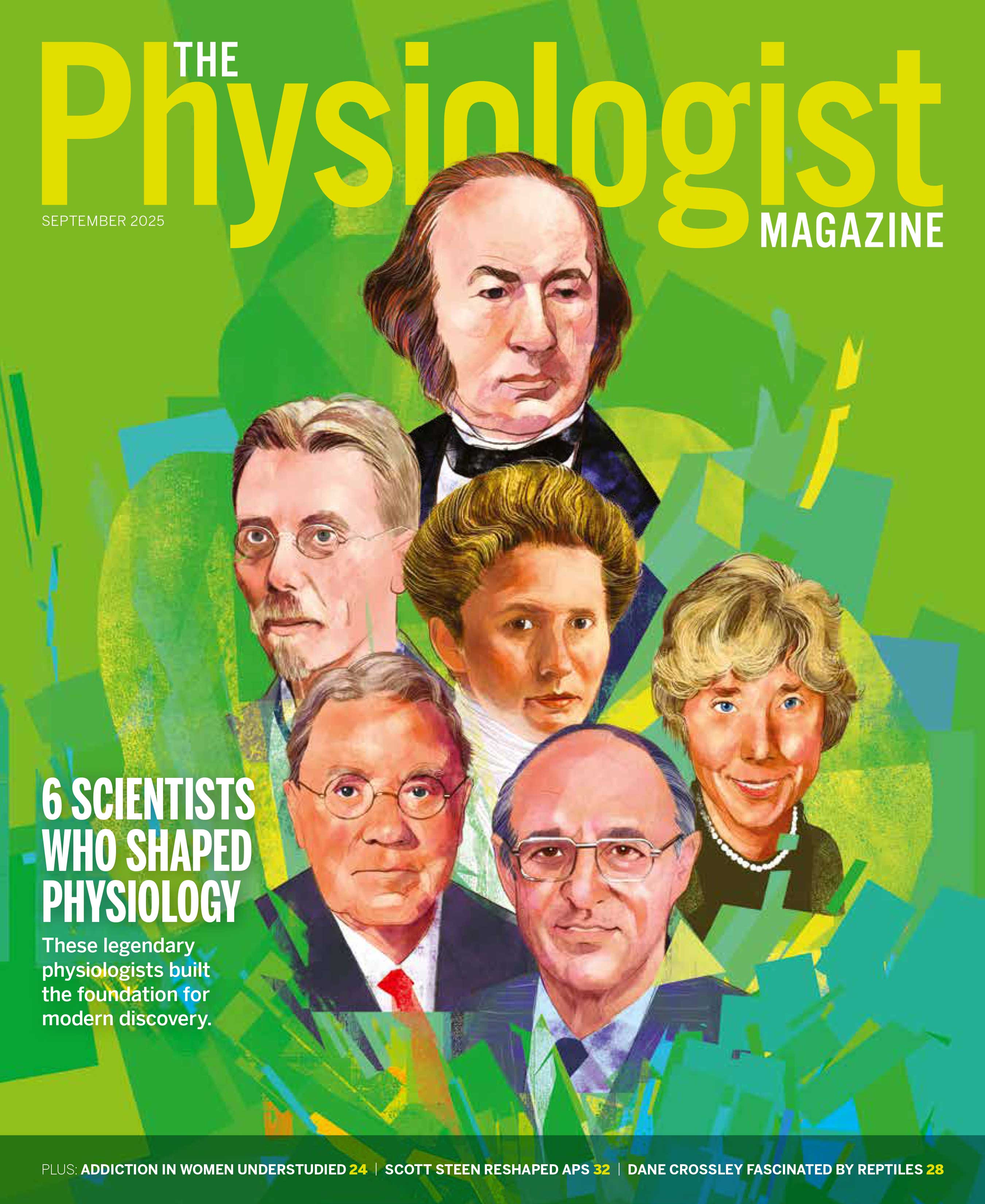The Breaking Point: Funding Uncertainty Threatens Scientific Innovation
Federal research funding delays and policy shifts are putting science careers and innovation at risk.
By Dara Chadwick

Physiologists are no strangers to uncertainty. After all, ambiguity, complexity and variability are inherent in science. Yet amid scientific uncertainty, researchers and laboratory teams have long been able to rely on the mostly predictable system of federal research funding.
Until now, that is. Researchers, trainees and institutions across the U.S. have been reeling from the effects of the new administration’s actions changing how scientific research is prioritized and funded. In the administration’s first six months, researchers faced everything from efforts to cap indirect cost funding at 15% to workforce reductions and cancellations or delays in federal research grants.
Litigation to block these actions has further clouded the horizon for researchers. Carrie Wolinetz, PhD, senior principal and chair of the Health and Biosciences Innovation Policy Practice Group at Lewis-Burke Associates LLC, a Washington, DC-based government relations firm, likens this uncertainty to a “sword of Damocles” hanging over the heads of researchers.
Early in the new administration, we saw “rapid-fire executive action,” says Wolinetz, a longtime senior government official in biomedical research who previously held roles at the National Institutes of Health (NIH) and the White House. “Researchers don’t know the fate of their future funding. Institutions are being incredibly cautious about the future, which means everything from hiring freezes to rescinding offers to graduate students. The longer this period of uncertainty stays in place, the less likely it is that the damage can be reversed.”
Potential Effects on Science
Uncertainty around research funding can lead to decreased innovation, according to Daniel Michele, PhD, professor and chair of the Department of Molecular and Integrative Physiology at the University of Michigan in Ann Arbor and chair of the APS Science Policy Committee. Michele emphasizes that he speaks as a scientist and chair of the APS committee and not on behalf of the university.
“When funding is tight, scientists become more conservative,” he says. “They cannot risk the remaining funding they have left for their lab, so they have to propose and do the safest experiments that are most likely to be productive. As a consequence, innovation is stymied. Many groundbreaking discoveries are made by creative experiments that require exploratory funding.”
Exploration and innovation often take years. When it comes to bringing new drugs and treatments to market, funding is critical. Michele cites a study published in the April 2023 JAMA Health Forum that showed 356 new Food and Drug Administration-approved drugs between 2010 and 2019 were funded by NIH.
“Most of those drugs took almost 15 to 20 years to move from basic research discovery to a new drug,” Michele says. “A reduction in funding not only slows the development of new drugs but could also lead to projects being canceled and a huge loss of a 15- to 20-year investment in that discovery.”
Science is not quick, particularly for physiologists who are conducting whole system and whole organism-level experiments. “They’re planned out for weeks, months and years at a time,” Wolinetz says. “It’s hard to imagine these actions won’t slow the pace of research enormously and potentially delay the outcomes of that research for years.”
Michele also says his laboratory’s research has benefited from the creativity of early-career researchers, who are often much better at ignoring barriers or seeing beyond them and embracing new technologies. “An established investigator typically likes to lean on approaches that they have experience with and that they view as more likely to succeed,” he says. “We need early-career scientists from all walks of life to enter careers in science and bring their innovative ideas to our laboratories.”
A Disappearing Pipeline
Research funding uncertainties affect more than the pace of innovation. They also affect the career paths of future innovators.
Jeremy Berg, PhD, has held roles in academia prior to and after his role as former director of the National Institute of General Medical Sciences. Berg, who lives in the greater Pittsburgh area, is also the former editor-in-chief of Science.
Much academic biomedical research is conducted by trainees, according to Berg. “Young scientists who are learning are often eager, hardworking, smart and creative. They don’t yet know what’s impossible, so they just go ahead and do it anyway.”
Changes in grant funding directly affect graduate students and postdocs. Currently, NIH hasn’t been making awards at its typical pace, according to Berg. “As of March 1, the amount of money that hadn’t been received across the whole system was about $1.85 billion,” he says.
Berg compares the situation to a landlord whose tenants pay rent each month. “As a landlord, you know the rent is coming on a specific date,” he says. “Now, the money isn’t coming in and it’s stressing out the academic institutions. Some graduate programs are being downsized. Some are in sort of [a limbo] where nobody knows whether they’re accepting students.”
Fewer graduate students and postdocs means labs won’t have the people they need to conduct funded research. As the problem gets bigger, the flexibility of institutions to handle it may decrease, Berg says.
“If you have a hundred labs in your institution and five of them hit a rough patch, it’s not that hard to figure out how to put together a bridge funding program and find institutional sources or other sources of funding to keep people going through an interruption in grant funding,” he says. “If you have more labs being hurt and you’re also short tens of millions of dollars, your flexibility to do something about it is more limited.”
Not securing an expected grant and grant terminations can create a sense of discouragement, mistrust and despair, Berg says.
Fewer supported students and fellows could result in less research and in projects being canceled, Michele says. “Most academic labs are run like small businesses of five to 10 people,” he says. “Graduate students and postdoctoral fellows are the lifeblood of most academic research laboratories, typically representing 50% to 75% of the workforce in a lab.”
Yet Michele says what worries him the most is the future of scientists. “Running a laboratory has never been easy,” he says. “In the current uncertain funding environment and with possible future reductions in funding on the horizon, a career as a laboratory scientist may seem improbable.”
A Call to Action for Physiology’s Future
In an editorial in Function, APS CEO Scott Steen, CAE, FASAE, builds on the message he delivered at the 2025 American Physiology Summit. Steen confronts the mounting threats to biomedical research—from political interference and misinformation to funding instability and challenges to academic freedom. He urges the physiology community to remain bold, vocal and unified in defending science and the essential role of physiologists in improving health and understanding life. Read the full editorial.
Decreasing Global Strength
Early-career scientists leaving research and potentially not returning represents a “generational problem” that could ultimately make the U.S. less competitive globally, according to Wolinetz. Spontaneous firings, an even more competitive funding environment and limited freedom to follow the science in certain areas may have long-lasting ripple effects.
“Smart, talented young people have a diversity of options, and it becomes difficult to imagine a future where people will actively choose this pathway,” Wolinetz says. “That ends up being a huge loss for the country. While the U.S. is going through this period of immense transition and challenge, the rest of the world is seeing that as an opportunity and thinking, ‘How do we attract all that talent to our country?’”
Berg says the U.S. has already been losing postdocs for a while. “Opportunities to do research in China, India, Europe, Australia and the U.K. have been getting better over time,” he says. “All of a sudden, the U.S. is basically walking off the field saying, ‘We’re not going to compete in this space anymore.’”
Some early-career scientists are pursuing careers outside laboratory science, even during PhD training, according to Michele. “While it may seem counterintuitive, I encourage early-career scientists to make the most of the training they are getting in the laboratory doing experiments,” he says. “Future employers are looking to hire PhD scientists because they’re trained to be experts and innovators in laboratory science.”
Despite all these pressures, science has always shown a remarkable ability to flex and adapt to the current environment. One bright spot? Wolinetz says this period of uncertainty may come to an end as new leadership emerges at NIH. “We could see some of these pipelines that have been clogged begin to get unclogged relatively soon,” she says.
Ultimately, science has always been shaped by both funding priorities and politics, according to Michele.
Stay Informed and Engaged
In a shifting research landscape, staying connected to science policy is more important than ever. The APS advocacy hub offers opportunities for you to take action and stay informed. It’s a resource for researchers who want to understand what’s happening—and have a voice in what happens next.
“The HIV pandemic and the COVID pandemic first caused a lot of political and public turmoil but eventually resulted in a tremendous mobilization of resources and science to develop effective therapies and vaccines,” Michele says. “The ethical and political challenges of using human embryonic stem cells in research led to the discovery of induced pluripotent stem cell technologies that have revolutionized the study of human disease and new therapies.
“The past would indicate that science has continued to innovate in the face of political change or public disagreement, as well as changing funding priorities. We must continue to adapt and innovate.”
This article was originally published in the July 2025 issue of The Physiologist Magazine. Copyright © 2025 by the American Physiological Society. Send questions or comments to tphysmag@physiology.org.
The Physiologist Magazine
Read the Latest Issue
Don’t miss out on the latest topics in science and research.
Contact Us
For questions, comments or to share your story ideas, email us or call 301.634.7314.
3 Tips for Managing Uncertainty
There are strategies researchers can employ to get through challenging times.
Stay informed. Jeremy Berg, PhD, recommends physiologists stay informed about what’s happening so they can prepare. “With research that involves mouse lines, you can freeze embryos if you have to,” he says. “You can interrupt experiments and eventually have a path to restart.”
Focus on collaboration. Daniel Michele, PhD, recommends increasing collaboration among labs. “One way to strategize for a reduction in funding is to have several labs capitalize on the unique skills of a talented scientist,” he says. “If the institution has core facilities, in some cases it can be cost-effective to access existing experts for critical experiments compared to hiring the expert into your laboratory.”
Diversifying funding sources. Carrie Wolinetz, PhD, says diversifying funding when possible may be a smart move. “It’s an opportunity to think about sharpening your research focus,” she says. “Is there enough bridge funding to collect more preliminary data or think about different experimental approaches? It’s potentially an opportunity to get out of this cycle of chasing the next grant. But not every researcher or institution is going to have that luxury, unfortunately.”


